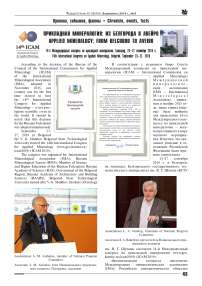Прикладная минералогия: из Белгорода в Авейро
Автор: Котова Ольга Борисовна
Журнал: Вестник геонаук @vestnik-geo
Рубрика: Хроника, события, факты
Статья в выпуске: 9 (297), 2019 года.
Бесплатный доступ
Короткий адрес: https://sciup.org/149128743
IDR: 149128743
Текст статьи Прикладная минералогия: из Белгорода в Авейро
September 2327, 2019 in Belgorod the V. G. Shukhov Belgorod State Technological University hosted the 14th International Congress for Applied Mineralogy ( icam2019) (ICAM 2019).
им. В. Г. Шухова) состоялся 14-й Международный конгресс по прикладной минералогии ( (ICAM 2019).
Организаторами конгресса выступили:
Международная минералогическая ассоциация (IMA); Российское минералогическое общество
named after Academician N. P. Yushkin FRC Komi SC UB RAS (IG FRC Komi SC UB RAS); Scientific and Production Corporation «Mekhanobr-Technika».
The National Organizing Committee included from Belgorod region: E. S. Savchenko — Governor of the Belgorod Region, Corresponding Member of RAS; S. N. Glagolev — Rector of V. G. Shukhov BSTU, Professor; V. V. Strokova — Professor of RAS, member of the RMS Academic Council. From the Russian Academy of Sciences: Academicians of the Russian Academy of Sciences D. V. Rundkvist, D. Yu. Pushcharovsky, A. O. Gliko; Corresponding Member of RAS V. V. Maslennikov; from the RAS Department of Earth Sciences — N. A. Zaytseva; from the RMS Commission for Technological Mineralogy and IG FRC Komi SC UB RAS I. N. Burtsev and N. N. Timonina.
The National Program Committee was headed by Academician L. A. Vaisberg. The Committee included representatives of leading scientific organizations of the Russian Academy of Sciences, industry organizations, universities and industrial associations — academicians of the Russian Academy of Sciences: A. M. Askhabov, N. S. Bortnikov; N. V. Sobolev; V. A. Chanturia; Corresponding members of the Russian Academy of Sciences: S. V. Krivovichev, Yu. B. Marin; Doctors of Sciences: T. N. Matveeva, O. B. Kotova, E. G. Ozhogina, O. V. Frank-Kamenetskaya, V. V. Shchiptsov.
(РМО); Министерство науки и высшего образования Российской Федерации; Российская академия наук (РАН); Правительство Белгородской области; Российская академия архитектуры и строительных наук (РААСН); Белгородский государственный технологический университета имени В. Г. Шухова (БГТУ им. В. Г. Шухова); Институт геологии имени академика Н. П. Юшкина ФИЦ Коми НЦ УрО РАН (ИГ ФИЦ Коми НЦ УрО РАН); Научно-производственная корпорация «Механобр-техника».
В состав Национального организационного комитета вошли от Белгородской области: Е. С. Савченко — губернатор Белгородской области, чл.-корр. РАН; С. Н. Глаголев — ректор БГТУ им. В. Г. Шухова, профессор; В. В. Строкова — профессор РАН, член Ученого совета РМО. От Российской академии наук — академики РАН Д. В. Рундквист, Д. Ю. Пущаровский, А. О. Глико; член-корреспондент РАН В. В. Масленников; от ОНЗ РАН — Н. А. Зайцева; от Комиссии по технологической минералогии РМО и ИГ ФИЦ Коми НЦ УрО РАН — И. Н. Бурцев и Н. Н. Тимонина.
Национальный программный комитет возглавил академик РАН Л. А. Вайсберг. В Комитет вошли представители ведущих научных организаций РАН, отраслевых организаций, ВУЗов и производственных объединений, академики РАН: А. М. Асхабов, Н. С. Бортников; Н. В. Соболев; В. А. Чантурия;
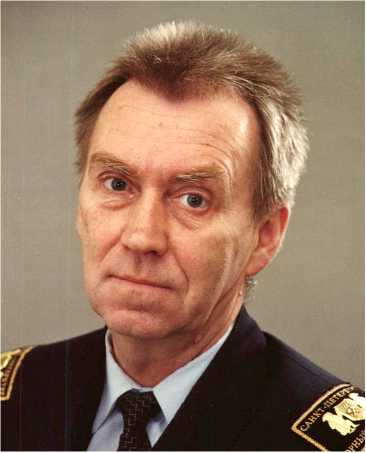
Dear Participants of the 14th International Congress for Applied Mineralogy!
On behalf of the Presidium of the Russian Mineralogical Society, let us congratulate you with this important scientific event and express our hope for the successful and productive work at its sessions and symposia.
Challenges that will be considered at the Congress, which is held in Russia for the first time, are exceptionally broad. They coincide with many directions that were recently developed by the Russian Mineralogical Society at its Commissionson technological mineralogy, environmental mineralogy and geochemistry, crystalchemistry and spectroscopy, and organic mineralogy.
In 2017, the Russian Mineralogical Society (RMS)
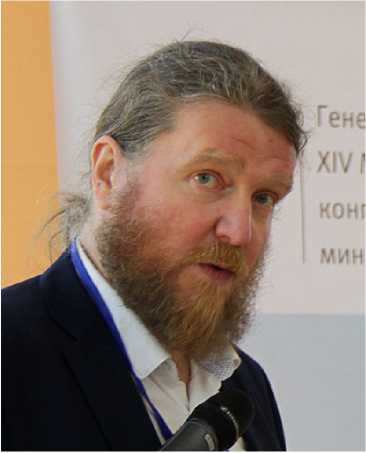
celebrated its 200th anniversary, and today, it unites more than twelve hundred members from different fields and disciplines. RMS sections are present in many scientifically important cities and mining regions of our country. RMS members are actively solving important problems of development and production of raw materials for nuclear, diamond, rare metal, and oil industries.
The continuing progress in microscopy (electron, tunnel, atomic force) brought mineralogical studies to the micro- and nanolevels. Intervention into micro- and nanoworlds is an important new stage of development of modern mineralogy and mineralogical crystallography. Due to the success in these fields, a range of new possibilities was opened for:
-
• prospecting and elaboration of novel types of mineral deposits,
-
• solution of the remediation problems for mining regions and the rational use of mine tailings,
-
• deeper understanding of the nature of oil fields, organic minerals and biominerals,
-
• creation of principally new geo-inspired materials with improved functional properties.
The methods of mineralogical sciences are still in the focus of problems that are faced by Earth sciences, rational use of natural resources, conservation of natural diversity, and cultural heritage of the humankind.
We are sure that the Congress will demonstrate a broad spectrum of important scientific discoveries, will develop new directions for research and exploration in applied mineralogy, and, last but not least, will provide a lavish basis for new professional contacts and collaborations.
Wishing you great inspiration, new discoveries, and achievements.
Yury B. Marin President of the Russian Mineralogical Society, Corresponding Member of the Russian Academy of Sciences Sergey V. Krivovichev
Vice-President of the Russian Mineralogical Society, Corresponding Member of the Russian Academy of Sciences
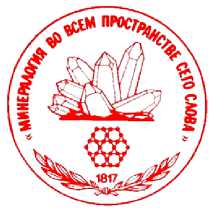
The International Committee included — from the ICAM Council: Saverio Fiore, President of the Council, Italy; Olga Kotova, Vice President of the Council, Russia; Council Secretary General, Dieter Rammlmair, Germany; from IMA-CAM Maarten A. T. M. Broekmans, Norway, Chair; Jan Elsen, Secretary, Belgium.
The general sponsor of the Congress was Management Company Metalloinvest.
Information support of the Congress was provided by the journals: Ore Dressing, Exploration and Mineral Protection, Building Materials, Bulletin of the Belgorod State Technological University named after V. G. Shu-khov, Ores and Metals, Vestnik of the Institute of Geology of Komi Science Center, Ural Branch of the Russian Academy of Sciences, Vestnik of the Department of Earth Sciences of the RAS.
The Congress target audience was researchers from Europe, Asia, America, Australia and Africa, who for five days presented their latest achievements and developments in research and application of the planet’s natural resources. 122 reports of 340 authors were announced for the Congress.
The opening ceremony of the Congress took place on September 23 in the Shukhov congress hall of BSTU. Welcoming speeches were made by representatives of the Belgorod Region, BSTU, the International Mineralogical Association, the Russian Academy of Sciences and the Russian Mineralogical Society.
The speakers of the Plenary session reflected the most significant problems of applied mineralogy. For example,
члены-корреспонденты РАН: С. В. Кривовичев, Ю. Б. Марин; доктора наук: Т. Н. Матвеева, О. Б. Котова, Е. Г. Ожогина, О. В. Франк-Каменецкая, В. В. Щипцов.
В состав Международного комитета вошли — от
Участникам XIV-го Международного конгресса по прикладной минералогии
Совета ICAM Саверио Фиоре (Saverio Fiore), президент Совета, Италия; Ольга Котова, вице-президент Совета,
‘^Ие наУ®-'
Участникам XIV-го Международного конгресса по прикладной минералогии
Уважаемые друзья и коллеги, дамы и господа!
От имени Отделения наук о Земле Российской академии наук искренне рад приветствовать участников XIV Международного конгресса по прикладной минералогии, который проходит впервые в России в замечательном русском городе Белгороде.
Направления работы Конгресса охватывают практически все области приложения минералогии к потребностям современной экономики и жизни общества.
Уверен, что мероприятие пройдет на высоком уровне и участники смогут плодотворно поработать и обсудить современные проблемы прикладной минералогии, а также ознакомиться с достопримечательностями Белгородской области.
Процветания нашей прекрасной планете Земля! С наилучшими пожеланиями,
Академик-секретарь Отделения наук о Земле Российской академии наук академик РАН
Глико
Россия;
генераль-
ный секретарь Совета, Дитер Раммлмайр, Германия; от IMA-CAM Мартин Брук-манс, Норвегия (председатель); Ян Элсен, Бельгия (секретарь).
Генеральным спонсором конгресса выступила ООО «Управляющая компания Металлоинвест».
Информационную
поддержку в организации Конгресса оказали журналы: «Обогащение руд», «Разведка и охрана недр», «Строительные материалы», «Вестник Белгородского государственного технологического университета им. В. Г. Шухова», «Руды и металлы», «Вестник Института геологии Коми НЦ УрО РАН», «Вестник Отделения наук о Земле РАН».
Целевой аудиторией Конгресса стали ученые из Европы, Азии, Америки, Австралии и Африки, в течение пяти дней представлявшие новейшие достижения и разработки в исследовании и применении природных богатств планеты. Для участия в конференции было заявлено 122 доклада 340 авторов.
Церемония открытия Конгресса состоялась 23 сентября в Шуховском конгресс-зале БГТУ. С привет-
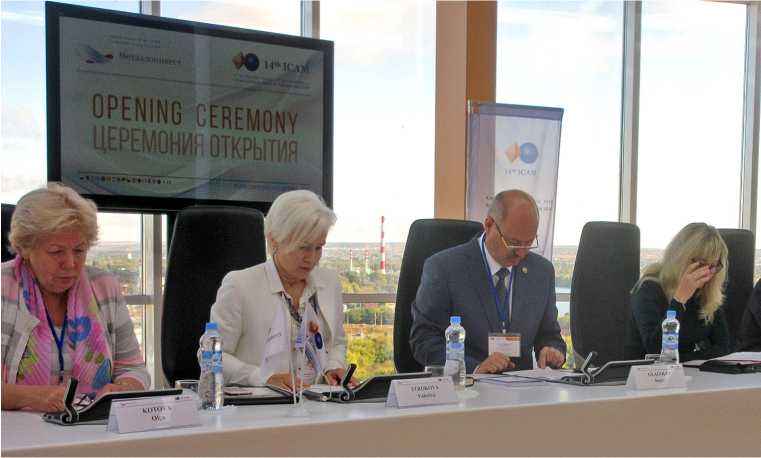
Shukhov Congress Hall. Opening Ceremony, conveners of plenary sessions (from left to right) Olga Kotova, IF FRC Komi SC UB RAS, and Valeria Strokova, Shukhov BSTU, Sergey Glagolev, Rector of Shukhov BSTU, Olga Pavlova, deputy governor of Belgorod region
ственными словами выступили представители Белгородской области, БГТУ, Международной минералогической ассоциации, Российской академии наук и Российского минералогического общества.
Основные научные направления, которые охватил Конгресс, коснулись современных методов исследования горных пород и минералов, полезных ископаемых, геометаллургии и процессов переработки, биоминералогии, функциональных материалов, углеводородного сырья, экологии, в рамках которых работали 9 секций. Сделано 16 пленарных, 70 устных и 36 стендовых докладов.
Докладчики пленарной сессии отразили наиболее значимые проблемы прикладной минералогии. Академик Асхаб Асхабов (ИГ ФИЦ Коми НЦ УрО РАН, Сыктывкар) в своем докладе, посвященном результатам и перспективам минералогического вторжения в нано-
Шуховский конгресс-зал, церемония открытия, оргкомитет пленарных заседаний (слева направо): Ольга Котова, ИГ ФИЦ Коми НЦ УрО РАН; Валерия Строкова, БГТУ им. В. Г. Шухова; Сергей Глаголев, ректор БГТУ им. В. Г. Шухова; заместитель губернатора Белгородской области Ольга Павлова
мир, среди прочего отметил появление прото-минерального мира в повестке дня минералогической науки и связал перспективы развития прикладной минералогической науки, в том числе прикладной минералогии, с программой
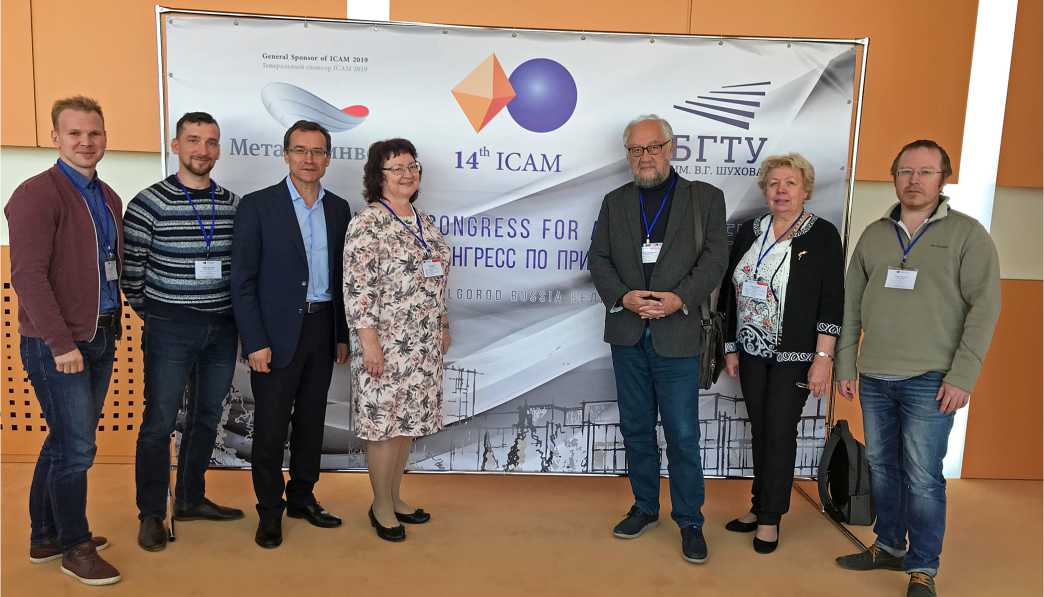
Delegation from the Institute of Geology (from left to right): Igor Perovsky, Aleksey Ponaryadov, Igor Burtsev, Natalia Timonina, Askhab Askhabov, Olga Kotova, Dmitry Kamashev
Делегация Института геологии (слева направо): Игорь Перовский, Алексей Понарядов, Игорь Бурцев, Наталья Тимонина, Асхаб Асхабов, Ольга Котова, Дмитрий Камашев
Academician A. M. Askhabov (IG FRC Komi SC UB RAS, Syktyvkar) noted the appearance of the protomineral world in the mineralogical science agenda and linked the development of applied mineralogy with a program of priority experiments to study nanobjects (in the range from individual atoms and molecules to the first “nanoindividuals” of mineral substance) with the use of the European XFEL.
Researchers assign the further development of interrelated problems of rational use of natural resources to a qualitatively new level of researches of the mineral and material composition of multicomponent ores, suggesting their methods and approaches, for example, from the perspective of complex and deep processing (Valentin Chanturia, Tamara Matveeva | Institute for the Problems of Integrated Subsoil Development of the Russian Academy of Sciences, Moscow) or from the point of view of innovation in engineering by the example of molybdenum-schee-lite ores (Leonid Vaysberg, Oleg Kononov, Ivan Ustinov | Mekhanobr-Tekhnika, St. Petersburg and Moscow State University, Moscow).
By combining their scientific potential in the field of technological mineralogy, Olga Kotova (IG FRC Komi SC, UB RAS, Syktyvkar) and Elena Ozhogina (VIMS, первоочередных экспериментов по изучению на-нобъектов (в диапазоне от отдельных атомов и молекул до первых «наноиндивидов» минерального вещества) с привлечением Европейского лазера на свободных электронах.
Дальнейшее развитие взаимосвязанных проблем рационального использования природных ресурсов ученые связывают с качественно новым уровнем исследований минерального и вещественного состава многокомпонентных руд, предлагая свои методы и подходы, например, с позиции комплексной и глубокой переработки (Валентин Чантурия, Тамара Матвеева | Институт проблем комплексного освоения недр РАН, Москва) или с позиции инноваций в инжиниринге на примере молибденошеелитовых руд (Леонид Вайсберг, Иван Устинов | НПО «Механобр-Техника», Санкт-Петербург и Олег Кононов | Московский государственный университет, Москва). Объединив свой научный потенциал в области технологической минералогии Ольга Котова (ИГ ФИЦ Коми НЦ УрО РАН, Сыктывкар) и Елена Ожогина (ВИМС, Москва) продемонстрировали алгоритм вовлечения во вторичную переработку отхо-
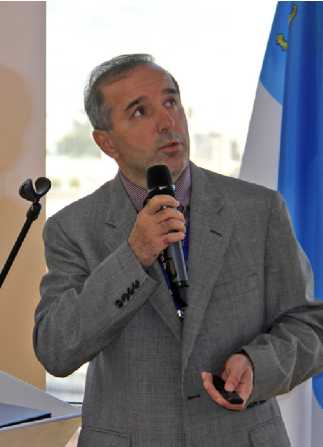
Here is the few words about Applied Mineralogy
As you know I use optical microscope (reflected one in particular) with EPMA, XRD and Raman to resolve problems arising from mineralogical issues in a fairly broad areas from process mineralogy to material science. Minerals are all around us since the early man. It appears that the tendency towards natural materials and dependence on natural resources will definetely continue. Thus importance and popularity of applied mineralogy will be increasing in the future.
Thanks for everything. I sure had a plesant time in Belgorod.
I enjoyed the Russian food as well. Organization was hastle free. All well organized. Congress hall was also impressive. All in all, it was a privilege for me.
Prof. Emin Ciftci
Istanbul Technical University Faculty of Mines
Department of Geological Engineering,
Istanbul, Turkey
Moscow) demonstrated the algorithm of involvement of mining wastes (enclosing and overburden rocks, off-balance ores, dumps) and processing (slags, sludges, ash slags, ashes) industries by the example of Ni- and Al-raw.
Chinese colleagues (Professors Faqin Dong, Qunwei Dai and Shiyong Sun, Southwest University of Science and Technology of China, Minyang) focused on the micro- organism-mineral-pollutant systems as an innovative ap- proach to increase control of hydrogeological landscape conditions (travertine of the main heritage sites of Jiuzhaigou), environmental pollution and environmental rehabilitation technologies.
Such a popular topic as “minerals as prototypes of advanced materials and mineral formation as the basis for the development of nature-like technologies” were also reflected in the plenary reports. We would like to emphasize the presentation of Corresponding Member of the Russian Academy of Sciences
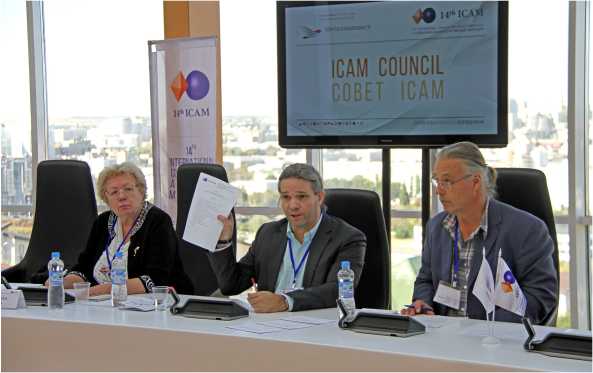
Shukhov BSTU, Shukhov Hall. ICAM Council meeting. Olga Kotova, Russia; Maarten Broekmans, Norway; Dieter Rammlmair, Germany
Шуховский зал БГТУ. Заседание Совета ICAM. Ольга Котова, Россия; Мартин Брукманс, Норвегия; Дитер Раммлмайр, Германия
Valery Maslennikov (Institute of Mineralogy, UB RAS), who summarized the results of 15 years of work together with Professor Ross Large (CODES — Center of Ore deposits research, Tasmania University) in the field of LA-ICP-MS geochemistry of massive sulfide and orogenic gold deposits. German colleagues emphasized the importance of the geochemistry and mineralogy of the tailings of a copper mine in northern central Chile in the formation of the country economic potential and strategies to reduce environmental impact (K. Berkh, D. Rammlmair, M. Drobe, J. Meima “Case study: Geochemistry and mineralogy of Copper mine tailings in northern centralChile”). Corresponding Member of the Russian Academy дов горнодобывающих и перерабатывающих производств на примере Ni- и Al- сырья.
Китайские коллеги (профессора Faqin Dong, Qunwei Dai и Shiyong Sun | Юго-Западный университет науки и техники Китая, Миньянг) сфокусировали внимание на системе микроорганизм — минерал — поллютант, основе инноваций повышения возмож- ностей в поле контроля гидрогеологических условий ландшафта (на примере травертина основных объектов наследия Цзючжайгоу), загрязнения окружающей среды и технологий экологической реабилитации.
Член-корреспондент РАН Валерий Масленников (Институт минералогии УрО РАН) в докладе обобщил результаты 15 летней работы совместно с профессором Ross Large (CODES — Centre of Ore deposits research, Tasmania University, Australia) в области
LA — ICP-MS геохимии массивных сульфидных и орогенных месторождений золота.
Немецкие коллеги подчеркнули важность геохимии и минералогии хвостов при формировании экономического потенциала страны и стратегии уменьшения воздействия на окружающую среду на примере медного рудника на севере центральной части Чили (K. Berkh, D. Rammlmair, M. Drobe, J. Meima «Case study: Geochemistry and mineralogy of Copper mine tailings in northern central-Chile»).
Член-корреспондент РАН Сергей Кривовичев с соавторами в докладе предложили муратаит-пирох-лор титанатную керамику на основе отходов, способ-
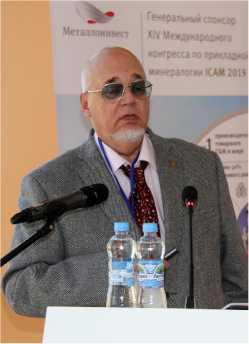
T1: geometallurgy, thechnological mineralogy and processing of mineral raw
Section T1 appears to be central to Congress (not to mention, of course, plenary presentations).
My view of the situation is that the dominant reports in the field of applied mineralogy and metallurgy of ore deposits were studies of the material composition of finely disseminated non-ferrous and ferrous metals, fundamental prerequisites for the use of combined processing technologies for refractory ores and industrial wastes, as well as studies of promising types of ores containing layered and clay minerals. That is, the topics of the reports were quite in the trend of developing the fundamental foundations for improving the technology of tomorrow.
Among the outstanding reports at T1 section, I would like to mention a series of reports by Emin Chiftci on the study of extremely finely disseminated polymetallic ores in the northern part of Turkey, a report by Olga Kotova on the effect of accelerated electrons on the structure of minerals, and a report by Andrey Gerasimov on the effect of layered silicates on the physicochemical properties of ores and thermochemical control of these properties.
General impression. The work of the congress was well organized. At all stages of the preparation and conduct of the Congress we felt a confident leadership of Professor Olga Kotova, and at the stage of the Congress itself, the active positive influence of Professor Valeria Strokova. The genuine hospitality of the receiving party was constantly felt. The friendly attitude towards the members of the permanent members of the ICAM Council, as well as members of the organizational and program committees of the congress, was very noticeable.
Prof. Ivan Ustinov —
Research and Engineering Corporation Mekhanobr-Tekhnika, St.-Peterburg, Russia of Sciences Sergey Krivovichev with co-authors suggested murataite-pyrochlore titanate ceramics as an attractive form of wastes, which could immobilize flows of radioactive wastes of complex composition, which would eliminate chemical methods.
Natalia Timonina (IG FRC Komi SC UB RAS, Syktyvkar) re- ported on the influence of clay minerals of Triassic sandy reservoirs of Arctic regions of the Timan-Pechora oil and gas province on filtration and reservoir properties
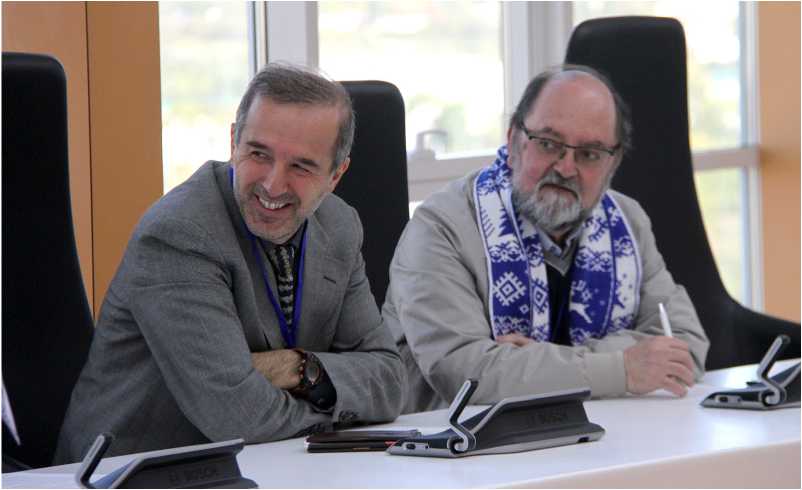
Shukhov Congress Hall; ICAM Council meeting; Emin Ciftci, Past ICAM President (Stambul, 2012) and Fernando Roche, Vice President of the new staff of the Council
Шуховский конгресс-зал; заседание Совета ICAM Эмин Чифчи, прошлый президент ICAM (Стамбул, 2012) и Фернандо Роче, вице-президент нового состава Совета
of the latter, assessment of quality of reservoirs and caps to increase the efficiency of oil recovery and hydrocarbon production.
Reports of BSTU scientists (Valery Lesovik et al.), as well as French colleagues (Gwenn LE SAOUT, Rachida IDIR, Jean Claude ROUX | IMT Mines ALES, Ales, France; CEREMA, DIM project team, Provins, France “Study of a calcium sulfo aluminate cement”) raised the problems of applied mineralogy in the building industry.
The report by Olga Frank-Kamenetskaya et al. (Dmitry Vlasov, Vera Rytikova, Vadim Parfenov, Vera Manurtdinova, Marina Zelenskaya | St. Petersburg State University, St. Petersburg, Russia; State Museum of Urban Sculpture, St. Petersburg, Russia; St. Petersburg Electrotechnical University “LETI”, St. Petersburg) “Monitoring of the state of St. Petersburg stone monu- ную иммобилизовать радиоактивные отходы сложного состава, что исключает необходимость использовать химические методы.
Доклад Фернандо Роча с коллегами из португаль- ского университета г. Авейро был посвящен улучшению свойств геополимеров на основе отходов («Properties Improvement of Metakaolin-Zeolite-Diatomite-Red Mud
Доклад Натальи Тимониной (ИГ ФИЦ Коми НЦ УрО РАН, Сыктывкар) был посвящен влиянию глинистых минералов песчаных пород-коллекторов триасового возраста арктических районов Тимано-
Печорской нефтегазоносной провинции на фильтрационные и емкостные свойства последних, оценке качества коллекторов и покрышек с це- лью повышения эффективности нефтеотдачи пласта и увеличению объемов добычи углеводородов.
Доклады ученых БГТУ (Валерия Лесовика и др.), а также французских коллег (Gwenn Le Saout, Rachida Idir, Jean Claude Roux | IMT Mines ALES, Ales, France; CEREMA, DIM project team, Provins, France «Study of a calcium sulfo aluminate cement») подняли проблемы прикладной минералогии строительной индустрии.
В докладе Ольги Франк-Каменецкой с соавторами (Dmitry Vlasov, Vera Rytikova, Vadim Parfenov, Vera Manurtdinova, Marina Zelenskaya | St. Petersburg State University; State Museum of Urban Sculpture; St. Petersburg Electrotechnical University «LETI», St. Petersburg, Russia) «Monitoring of the state of St. Petersburg stone monuments and the strategy of their preservation» были отражены проблемы, связанные
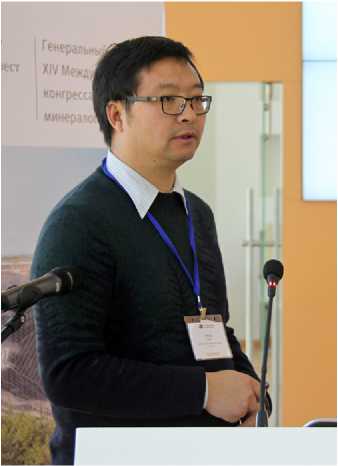
Applied mineralogy corresponds to theoretical mineralogy, both of which are important components of mineral science and engineering. It is differentiated from the traditional branch disciplines such as describing mineralogy and history of mineral science. It grew up on the basis of the mutual penetration of mineralogy and related disciplines, the rapid development of modern test and analysis methods, and the practical application of modern industrial and agricultural production and scientific and technological requirements of mineralogy. Combining modern mineralogy with traditional and emerging disciplines such as physics, chemistry, computational simulation, agriculture, biology, mineral processing, metallurgy, materials science and environment, many active interdisciplinary and applied mineralogy branches such as nanomineralogy and computational mineralogy have been formed. Therefore, applied mineralogy is a bridge and link between mineralogy and comprehensive utilization of mineral resources, solid waste recycling and related disciplines. Its rise and development are the inevitable product of modern scientific theory and technological progress, and will continue to play a greater role in industrial and agricultural production, people's daily life and national economy.
Prof. Shiyong Sun, Director of Department of Geological Engineering of Southwest University of Science and Technology of China ments and the strategy of their preservation” reflected the problems associated with the preservation of stone monuments in the urban environment: identification of a stone monument, development of methods for monitoring the state of a stone and strategy for stone preservation.
The presentation by Emin Qiftgi, Professor at the Technical University of Istanbul, showed samples of smoky quartz, blue chalcedony, emerald and other semiprecious and precious stones from Turkish deposits. The analytical capabilities of their study were demonstrated. Emin Зiftзi believed that with the increase of scientific knowledge and technical capabilities, gemology as a direction of applied mineralogy was experiencing its golden age (Emin Qiftgi, Haluk Selim, Huseyin Sendir | Istanbul Technical University, Istanbul, Turkey; ITICU, Istanbul, Turkey; EOGU, Odunpazar, Eskisehir, Turkey “Authentic semi-precious and precious gemstones of Turkey: special emphasis on the ones preferred for prayer beads”).
Sections worked during three days of the Congress.
The main scientific areas, covered by the Congress, touched on modern methods of the study of rocks and minerals, metallurgy and processing processes, biomineralogy, functional materials, hydrocarbon raw, ecology, in which 9 sections worked, 16 plenary, 70 oral and 36 poster presentations were made. Section T1 “Geometallurgy, с сохранением памятников в городской среде: идентификация памятников, разработка методов мониторинга состояния камня и стратегии его сохранения.
В презентации профессора Технического университета Стамбула Эмина Чифчи были представлены образцы дымчатого кварца, синего халцедона, изумруда и других полудрагоценных и драгоценных камней из месторождений Турции, продемонстрированы аналитические возможности их исследования. Эмин Чифчи считает, что сегодня с увеличением научных знаний и технических возможностей геммология как направление прикладной минералогии переживает свой золотой век. (Emin Qiftgi, Haluk Selim, Huseyin Sendir | Istanbul Technical University; ITICU, Istanbul; EOGU, Odunpazar, Eskisehir, Turkey «Authentic semiprecious and precious gemstones of Turkey: special emphasis on the onespreferred for prayer beads»).
Секционные заседания работали в течении трех дней Конгресса. Секция Т1 «Геометаллургия, технологическая минералогия и процессы переработки минерального сырья» была самой представительной с акцентом на исследования вещественного состава тонковкрапленных руд цветных и черных металлов. Чувствовалось доминирование комбинированных технологий переработки труднообогатимых руд и промышленных отходов. Большой интерес вызвали докла-
T6. 'Applied mineralogy' of building materials
Conversely, even when the effect of low-CO2 emission production methods for OPC-alternatives may be limited if measured per unit weight, the reduction potential is gigantic if sufficient OPC gets replaced by low-CO2 alternatives.
A number of low-CO2 emission OPC alternatives have garnered attention from mineralogists in the past decades, eg. involving clays, zeolites, or sulfo-aluminates in the calcination to wholly or partially replace limestone. The starting materials, the details of the metamorphic reactions taking place during clinkering, the clinker products, as well as the hydration reactions and products fresh
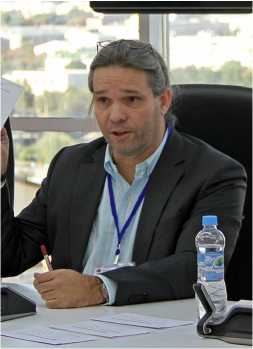
and aged need characterization in adequate detail, to optimize production (ie. CO2-reduction potential) as well as performance in real-life structures (eg. hydropower dams, nuclear plants, power lines, roads and railroads, coastal defense works, edifices and residential dwellings).
The understanding of long-term performance of novel OPC-alternative clinker constituents has benefited greatly from research on natural rock analogues, notably naturally combusted impure limestones and other lithologies intercalated with coals seams, long ago ignited by lightning or bush fire.
Another issue (unrelated to cementitious binders) is the spontaneous failure of toughened glass caused by tiny spherical inclusions of nickel-sulfide, contamination from glass production. The included metastable high-temperature polymorph slowly transforms to its stable low-temperature form over 2-10y, depending on detailed chemical composition and formation conditions, expanding some 7vol%. Ultimately, the toughened glass shatters spontaneously but explosively from the internal growing tension, damaging shower doors, salon tables, railway stations, pedestrian passage ways, facades on high-rise buildings, as well as their human users. While improved quality control and post-manufacture heat-treatment have reduced spontaneous breakage cases, better understanding of nickel-sulfide origin and behavior with temperature may still further enhance material use and user safety.
Above topics are just personal favorites from a much, much broader range of topics within 'applied mineralogy of building materials'. Regardless of topic chosen, and irrespective of what advanced instrumentation was used, however, the validity of obtained results can only be verified by specification of all materials, experimental and/or analytical procedures, instrumentation, settings and operating conditions, etc, in adequate detail. There is an unfortunate trend in reporting findings increasingly without such specification, also in prestigious journals. When important details are missing, experiments cannot be repeated, and results not reproduced, representing a demise of science fundamentals.
In summary, there is a clear demand for 'Applied mineralogy' of building materials, whether glass, concrete, alternative cementitious binders, or other materials used in construction, including teaching to students as much as 'outreach to society'.
Dr. Maarten A. T. M. Broekmans, Norway technological mineralogy, and mineral processing processes” was the most representative with an emphasis on the study of the material composition of finely disseminated non-ferrous and ferrous metals. The combined processing technologies for refractory ores and industrial wastes dominated. The reports on advanced types of ores containing layered and clay minerals were interesting. The reports presented at Section T2 “Industrial minerals, precious stones, ores and mining” demonstrated the importance of applied mineralogy in as
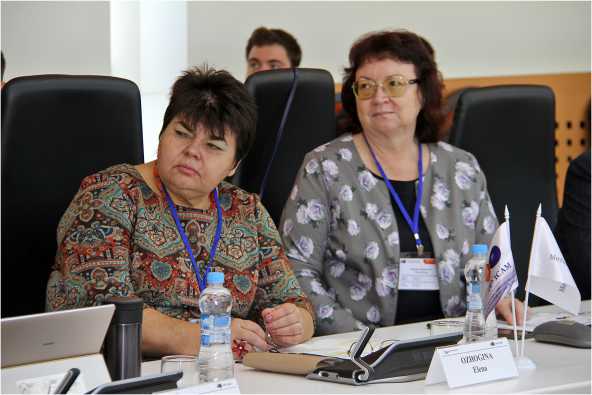
Shukhov Congress Hall: member of National Program Committee Elena Ozhogina, VIMS, and member of National Organization Committee Natalia Timonina, IG FRC Komi SC UB RAS
Шуховский конгресс-зал: член Национального программного комитета Елена Ожогина, ВИМС и член Национального организационного комитета Наталья Тимонина, ИГ ФИЦ Коми НЦ УрО РАН
ды в области исследования перспективных типов руд, содержащих слоистые и глинистые минералы.
Доклады, представленные на секции Т2 «Индустриальные минералы, драгоценные камни, руды и добыча полезных ископаемых», продемонстрировали важнейшее значение прикладной минералогия при оценке металлов и промышленных минералов, драгоценных камней в условиях жесткой конкуренции, дефицита сырья и экологических рисков.
Остальные секции
sessing metals and industrial minerals, precious stones in under fierce competition, raw materials deficit and environmental risks.
Other sections also demonstrated achievements in their fields involving mineralogical researches. It seemed that the trend towards natural minerals and dependence on natural resources would definitely continue. Thus, the importance and popularity of applied mineralogy would increase in the future.
The important result of the Congress was a book of almost 500 pages — Proceedings of the 14th International Congress for Applied Mineralogy (ICAM2019), edited by Professor S. N. Glagolev, Rector of Shukhov Belgorod State Technical University, which were published by Springer (Springer open https://link. springer. com/ book/10.1007/978-3- 030-22974-0), a part of the Springer Proceedings in Earth and Environmental Sciences series.
также демонстрировали достижения в своих областях с привлечением минералогических исследований. Похоже, что использование природных минералов и зависимость от природных ресурсов определенно сохранится. Таким образом, значимость и популярность прикладной минералогии в будущем будет возрастать. Важным результатом Конгресса стала книга в почти 500 страниц — Труды 14-го Международного конгресса по прикладной минералогии (ICAM2019), под редакцией профессора С. Н. Глаголева, ректора Белгородского государственного технологического университета им. В. Г. Шухова, которые были опубликованы в издательстве Шпрингер.
Согласно итогам выпущенного издания и с учетом всех зарегистрированных делегатов в работе Конгресса приняли участие более 400 ученых и специалистов в области прикладной минералогии из 21 стра-
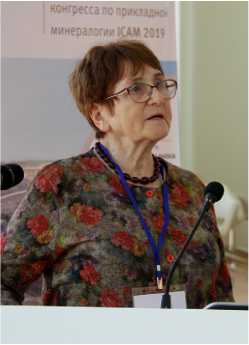
T9: Cultural heritage, artifacts and their preservation
The reports presented in this area covered various problems associated with the conservation of stone monuments in the urban environment: identification of monument stone, the development of methods for monitoring the state of the stone and strategy of stone preservation (Olga Frank-Kamenetskaya, St. Petersburg State University, Russia). In addition, significant attention was paid to the study of stone collections represented in geological and mineralogical museums (Natalia Borovkova, | Mining museum of the Mining university, St. Petersburg, Russia) and the problems of archaeological mineralogy: the study of historically important artifacts (Fernando Rocha University of Aveiro, Portugal).
Ò7: Biomimetic materials on a mineral basis, biomineralogy
The reports presented in this area covered a wide range of fundamental and applied problems of biomineralogy and biomimetic material science. The reports of russian scientists were devoted to the mechanisms of pathogenic mineral formation in physiological fluids of the human body: in urine (Alina Izatulina, | St. Petersburg State University, Russia) and blood (Anatoly
Titov, National Research University, Novosibirsk, Russia). Chinese scientists from Lanzhou Institute of Chemical Physics presented their achievements in creating new biomimetic material: superhydrophobic cobalt blue/clay mineral hybrid pigments with self-cleaning property (Bin Mu), ZnO/palygorskite nanocomposites for antibacterial application (Yuru Kang) and macroporous adsorbent based on montmorillonite (Feng Wang).
Prof. Olga Frank-Kamenetskaya
Dept. of Crystallography St.-Petersburg State University Vice-president of the St. Petersburg Society of Naturalists
According to the results of the Proceedings and list of all registered delegates, more than 400 scientists and specialists in the field of applied mineralogy from 21 countries of the world (Russia, China, Portugal, Germany, Japan, Turkey,
Uzbekistan, France, Chile, Kazakhstan, Australia, Belarus, the USA, Hungary, Spain, Romania, Lebanon, Cote d'Ivoire, Algeria, Italy, Norway) took part in the Congress. The participants were from 46 organizations, 29 delegates were representatives of academic organizations, 44 — higher educational institutions, 23 — representatives of industri companies, scienti ic journals, includin 8 Academicians o the Russian Academ of Sciences, Corresponding mem bers of RAS, docto and candidates of sci ences, engineers, en trepreneurs, graduat
ICAM2019: Proceedings of the Congress
Springer Proceedings in Earth and Emriroimental Sciences
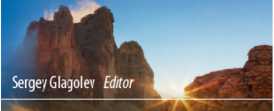
14th International Congress for Applied Mineralogy (ICAM2019)
Belgorod State Technological University namedafterV.G.Shukhov, 23-27 September 2019, Belgorod, Russia
^ SpringerOpen
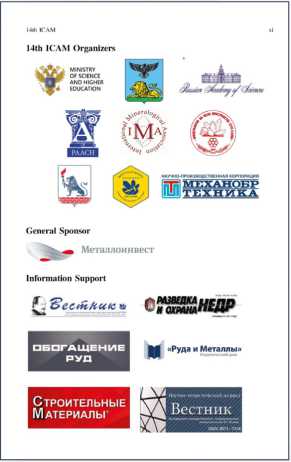
ICAM2019: Authors, Editors and Reviewers by Countries
Список литературы Прикладная минералогия: из Белгорода в Авейро
- Прикладная минералогия: из Бари в Белгород // Вестник Института геологии Коми НЦ УрО РАН. 2018. № 4. С. 51.

